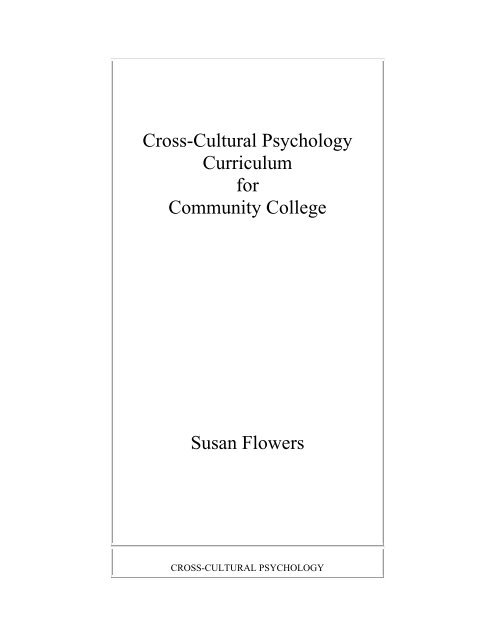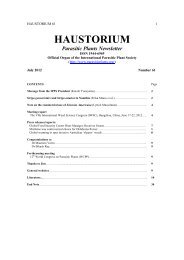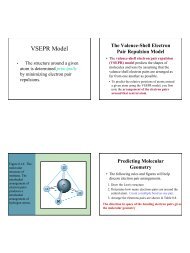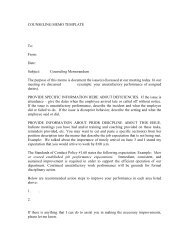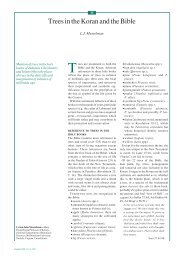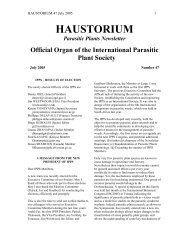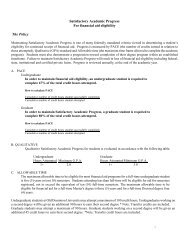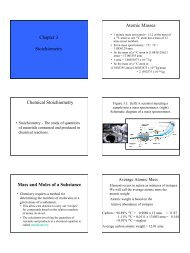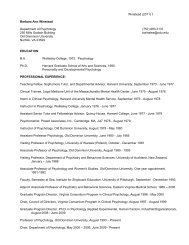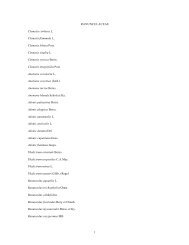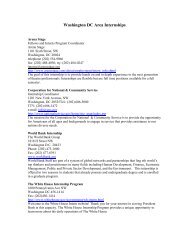Cross-Cultural Psychology Curriculum for Community College ...
Cross-Cultural Psychology Curriculum for Community College ...
Cross-Cultural Psychology Curriculum for Community College ...
You also want an ePaper? Increase the reach of your titles
YUMPU automatically turns print PDFs into web optimized ePapers that Google loves.
<strong>Cross</strong>-<strong>Cultural</strong> <strong>Psychology</strong><br />
<strong>Curriculum</strong><br />
<strong>for</strong><br />
<strong>Community</strong> <strong>College</strong><br />
Susan Flowers<br />
CROSS-CULTURAL PSYCHOLOGY
CURRICULUM<br />
FOR COMMUNITY COLLEGE<br />
DEFINITION OF CROSS-CULTURAL<br />
PSYCHOLOGY<br />
<strong>Cross</strong>-cultural psychology is the attempt to<br />
describe and explain differences and similarities in<br />
human behavior in terms of psychological<br />
concepts with reference to ecological and<br />
sociocultural factors (Lonner & Berry, 1986).<br />
Human behavior appears uni<strong>for</strong>m but higher levels<br />
of analysis reveal diversity through social<br />
interaction and material culture. <strong>Cross</strong>-cultural<br />
psychological research studies relationships<br />
between behavioral variables within social systems<br />
and between social systems. The term "crosscultural"<br />
is not meant to implicate restricting study<br />
to only two cultures; three-culture studies as a<br />
minimum are recommended <strong>for</strong> meaningful<br />
comparisons. Discussion in literature is moving<br />
towards more suitable labeling of this field since it<br />
is inevitable that psychology needs to incorporate<br />
cultural influence in its research. It has been<br />
suggested that psychology as a social science<br />
should be incorporating inherent cross-cultural<br />
influences in all of its research rather than<br />
delineating cross-cultural psychology as a separate<br />
field of study.<br />
RATIONALE FOR CROSS-CULTURAL<br />
PSYCHOLOGY IN THE COMMUNITY<br />
COLLEGE<br />
For the past century, Western psychologists have<br />
emerged with theories of the psyche largely<br />
generalized to the whole of humanity.<br />
Traditionally, psychological data has been derived<br />
from mainly white, middle-to-upper class level<br />
college students with male-gender bias.<br />
Generalization of theories have been made to non-<br />
Western cultures, ethnic minorities in Western<br />
societies and across gender. This methodology<br />
may have achieved perfecting psychology as a<br />
science in terms of research control; yet serious<br />
application of theory is undermined by the lack of<br />
consideration <strong>for</strong> culture as a factor in human
ehavior. The field of psychology can no longer<br />
conduct legitimate human behavioral research in a<br />
vacuum.<br />
Culture is an all encompassing context <strong>for</strong> the<br />
developing individual. In terms of social behavior,<br />
culture is the reflection of attitudes, beliefs,<br />
expectations and actions subscribed to by members<br />
within a social setting. However, culture is never<br />
static. It is as much a product of human behavior as<br />
it is creator of human behavior. The influence of<br />
culture is entwined in human behavior with<br />
subtleness as well as distinction. The social<br />
sciences of group behavior, anthropology and<br />
sociology have strived to assess the effects of<br />
culture. <strong>Psychology</strong> has been more intent on the<br />
study of individual behavior, working to eliminate<br />
as many confounding variables as possible in order<br />
to define universal traits. Culture has proven to be<br />
a <strong>for</strong>midable variable despite stringent research<br />
control. Consequently, in the last twenty-five years<br />
a movement has slowly emerged to incorporate<br />
cultural influences into psychological<br />
methodology. <strong>Psychology</strong> is finally recognizing<br />
human behavior as only meaningful when viewed<br />
within the sociocultural context in which it occurs.<br />
Up until recently, cross-cultural research was<br />
considered costly, difficult and time-consuming.<br />
However, the rapid blending of global populations<br />
has made cross-cultural research a necessity.<br />
Social, technological and economical boundaries<br />
no longer reside at national borders.<br />
Telecommunication, travel and international trade<br />
are incorporating cultural exchange at a seemingly<br />
endless pace. Understanding other cultures is<br />
becoming necessary <strong>for</strong> global citizenship.<br />
Recognition of similarities and differences in<br />
human behavior will provide understanding and<br />
hopefully, lead to appreciation of other cultures,<br />
lessening the effects of discrimination and<br />
prejudice.<br />
2
<strong>Cultural</strong> psychology digs into the thoughts,<br />
emotions and behaviors of humans to bring to light<br />
unification as well as diversity. Offering crosscultural<br />
psychology at the community college level<br />
will offer insight of variances in human behavior<br />
to those who pursue higher levels of education <strong>for</strong><br />
purposes of work and self-enrichment.<br />
Opportunities to develop relationships with diverse<br />
people abound through work, education and<br />
recreation. Knowing how culture shapes human<br />
behavior and how individuals design culture<br />
should foster benevolent interpersonal<br />
relationships.<br />
CONTENT SOURCE FOR CROSS-CULTURAL<br />
PSYCHOLOGY<br />
To appreciate psychology's status as a science and<br />
a profession, one should have a world view<br />
(Sexton & Misiak, 1976). In this cross-cultural<br />
psychology course, world view will be presented<br />
in examining culture and its influence on self and<br />
other as discovered through psychological<br />
methodology.<br />
Culture as a product as well as a shaper of human<br />
behavior has not received much attention within<br />
the field of psychology relative to the overall<br />
accumulation of psychological research.<br />
Fortunately this is changing with more published<br />
research becoming available each year. The rate of<br />
cultural change and the resulting range of<br />
behavioral patterns is being assessed and shared<br />
through international organizations, symposiums<br />
and literature. By measuring cultural change and<br />
behavioral patterns, psychological attributes of<br />
human development are qualified and quantified<br />
worldwide.<br />
Are psychological attributes universal or nonuniversal?<br />
Is culture acting as a treatment variable<br />
leading to variability in human behavior? Or is<br />
culture a system with complex interrelationships<br />
between treatment variables, defining the<br />
psychological makeup of an individual and<br />
inextricably woven into the cause as well as the<br />
effect of behavior? These debated issues have<br />
affected psychological methodology by altering the
accepted definition of scientific research. Quasiexperimental<br />
design in field studies has been<br />
slowly received as a reliable method bearing valid<br />
conclusions from research data. Problems of<br />
design, issues in design, and strategies <strong>for</strong> design<br />
need to be a part of coursework in cross-cultural<br />
psychology.<br />
Historically, the field of psychology began with<br />
intensive study of human behavior and human<br />
development, specifically child development,<br />
within different cultural and natural environments.<br />
However, the initial enthusiasm in this direction<br />
turned to refining research methods through better<br />
controlled design which left behind cultural<br />
considerations in research up until the 1950's.<br />
In the 1960's when world events aroused interest in<br />
international affairs, the field of psychology<br />
reinvigorated research in the study of cultural<br />
influence on language and cognitive development.<br />
This was the advent of concern <strong>for</strong> the<br />
generalization of theories developed in Western<br />
settings. Since the mid-1970's, culture as context<br />
<strong>for</strong> human psychological development has been<br />
strengthened through conceptual and<br />
methodological advancements. An accumulation of<br />
cultural research is now evident in the areas of<br />
personality, lifespan development, cognition,<br />
perception and language to be included in this<br />
course.<br />
<strong>Cross</strong>-cultural psychology postulates that the<br />
influence of culture is constantly pressuring social<br />
behavior to change. The politics, economics, and<br />
demographic make-up of a society illustrate<br />
cultural changes. Psychological methodology<br />
measures these changes through social distance,<br />
change in values and attitudes, and individual<br />
receptivity to other individuals, groups, and events.<br />
Sociocultural changes will be examined in terms of<br />
enculturation, acculturation, ethnocentrism, social<br />
3
ehavior, and gender roles. The effects of cultural<br />
influences on organizations, work environments,<br />
and health, illness, and health care delivery will<br />
also be included in coursework. A discussion of<br />
the movement towards a global community<br />
psychology is addressed at the conclusion of the<br />
course.<br />
CONTENT STRUCTURE FOR CROSS-<br />
CULTURAL PSYCHOLOGY<br />
(See Figure 1)<br />
CROSS-CULTURAL PSYCHOLOGY COURSE<br />
AIMS<br />
A community college course in cross-cultural<br />
psychology will provide experiences which will<br />
give:<br />
1. An understanding of the concept of culture.<br />
2. Recognition of variability in human<br />
behavior.<br />
3. Exposure to world views of human<br />
behavior.<br />
4. Awareness of sociocultural changes.<br />
5. The fostering of benevolence towards<br />
culturally diverse people.<br />
6. An understanding of cultural influences on<br />
everyday life.<br />
7. A conceptualization of Global <strong>Community</strong><br />
<strong>Psychology</strong>.<br />
CROSS-CULTURAL PSYCHOLOGY COURSE<br />
GOALS<br />
The goals of a cross-cultural psychology course in<br />
community college should include:<br />
1. Discussing the effects of culture on human<br />
behavior and how human behavior designs<br />
culture.<br />
2. Discussing universality and non-<br />
4
;<br />
universality of psychological traits,<br />
processes, and developments.<br />
3. Providing specific examples and findings<br />
of cultural research.<br />
4. Describing positive and negative<br />
sociocultural interactions.<br />
5. Discussing ways to reduce misconceptions,<br />
conflicts, prejudice and discrimination<br />
though enhancing understanding and<br />
coping with cultural changes.<br />
6. Discussing effects of culture on<br />
organizations, work environments, and<br />
health systems.<br />
7. Introducing Global <strong>Community</strong> <strong>Psychology</strong><br />
<strong>for</strong> the future of psychology as a science.<br />
CONTENT STRUCTURE FOR CROSS-<br />
5
CULTURAL PSYCHOLOGY<br />
Understanding Culture<br />
<strong>Cross</strong>-<strong>Cultural</strong> Research Methodology<br />
• Design Strategies<br />
• Design Problems<br />
• Design Issues<br />
Culture as Context <strong>for</strong> Human Development<br />
• Personality<br />
• Lifespan Development<br />
• Perception<br />
• Cognition<br />
• Language<br />
Sociocultural Changes<br />
• Social Behavior<br />
• Enculturation<br />
• Acculturation<br />
• Ethnocentrism<br />
• Gender Roles<br />
<strong>Cultural</strong> Influences On<br />
• Organizations<br />
• Work Environments<br />
• Health, Illness, &<br />
• Health Care Delivery<br />
Global <strong>Community</strong> <strong>Psychology</strong><br />
Figure 1
CROSS-CULTURAL PSYCHOLOGY SCOPE<br />
AND SEQUENCE<br />
COMMUNITY COLLEGE COURSE<br />
15 Weeks (6 Units)<br />
Unit One<br />
• Understanding Culture: What Is It? 1<br />
week<br />
Unit Two<br />
• <strong>Cross</strong>-<strong>Cultural</strong> Research<br />
Methodology<br />
• Design Strategies<br />
• Design Problems<br />
• Design Issues<br />
Unit Three<br />
• Culture as Context <strong>for</strong> Human<br />
Development<br />
• Personality<br />
• Lifespan Development<br />
• Perception<br />
• Cognition<br />
• Language<br />
Unit Four<br />
• Sociocultural Changes<br />
• Social Behavior<br />
• Ethnocentrism<br />
• Enculturation/Acculturation<br />
• Gender Roles<br />
Unit Five<br />
• <strong>Cultural</strong> Influences On<br />
• Organizations<br />
• Work Environments<br />
6<br />
2<br />
weeks<br />
5<br />
weeks<br />
4<br />
weeks<br />
2<br />
weeks
Unit Six<br />
• Health, Illness and Health<br />
Care Delivery<br />
• Global <strong>Community</strong> <strong>Psychology</strong><br />
1<br />
week<br />
UNIT ONE<br />
UNDERSTANDING CULTURE: WHAT IS IT?<br />
(One week)<br />
GOALS:<br />
1. To expose students to the complexity of<br />
defining culture.<br />
2. To make students aware of the interactive<br />
and mutually modifying relationship<br />
between individuals and their cultural<br />
environment.<br />
3. To initiate students into interpreting and<br />
understanding their own worldview.<br />
RATIONALE FOR UNIT:<br />
Most researchers agree culture is one of the most<br />
difficult terms to define in social science because<br />
of the various ways culture is perceived by<br />
individuals. Although one group of researchers<br />
compiled a list of 164 different definitions,<br />
Herkovits's (1948) definition of culture as "the<br />
man-made part of human environment" is the most<br />
used definition. Culture has numerous<br />
characteristics which range from concrete factors<br />
such as subsistence patterns, dwelling styles, and<br />
language to abstract concepts such as customs and<br />
7
eliefs which attempt to categorize behavioral<br />
phenomenon. Culture and human behavior is<br />
interactive resulting in a creative relationship<br />
between individuals and their surroundings.<br />
Defining and describing culture is a necessary<br />
beginning unit in a cross-cultural psychology<br />
course.<br />
OBJECTIVES FOR UNIT:<br />
1. To define and describe culture in social<br />
scientific terms.<br />
2. To demonstrate cultural values held by<br />
community college students.<br />
POSSIBLE ACTIVITIES:<br />
1. Read and discuss one or more of the<br />
suggested references describing culture.<br />
2. By using traditional American proverbs (or<br />
proverbs from another culture), analyze the<br />
core value each proverb contains. Discuss<br />
the meaning thoroughly, assessing the<br />
degree to which it still governs the behavior<br />
of Americans.*<br />
SUGGESTED REFERENCES:<br />
Berry, J. W., Dasen, P. R., & Saraswathi, T. S.<br />
(1997). Handbook of cross-cultural psychology:<br />
Vol. 2. Basic processes and human development.<br />
Introduction.<br />
Berry, J. W., Poortinga, Y. H., & Pandey, J.<br />
(1997). Handbook of cross-cultural psychology:<br />
Vol. 1. Theory and method. Ch. 1: History of<br />
cross-cultural and cultural psychology.<br />
Gardiner, H. W., Mutter, J. D., & Kosmitzki, C.<br />
(1998). Lives across cultures: <strong>Cross</strong>-cultural<br />
human development. Ch. 1: Introduction.<br />
Matsumoto, D. (1996). Culture and psychology.,<br />
Ch. 1: Introduction, Ch. 2: Understanding culture:<br />
What is it?
Moghaddam, F. M., Taylor, D.M., & Wright, S. C.<br />
(1993). Social psychology in cross-cultural<br />
perspective. Ch. 1: Culture and social psychology.<br />
* Seelye, H. N. (1996). Experiential activities <strong>for</strong><br />
intercultural learning, Vol. 1. Ch. 10: U. S.<br />
proverbs and core values.<br />
Segall, M.H., Dasen, P. R., & Berry, J. W., &<br />
Poortinga, Y. H. (1999). Human behavior in global<br />
perspective. Ch. 1: The sociocultural nature of<br />
human beings.<br />
8
GOALS:<br />
UNIT TWO<br />
CROSS-CULTURAL RESEARCH<br />
METHODOLOGY<br />
Design Strategies, Problems and Issues<br />
(Two weeks)<br />
1. To understand the importance of assessing<br />
human behavior within the context of its<br />
cultural environment.<br />
2. To recognize the complexity in determining<br />
cultural effects on human behavior.<br />
RATIONALE FOR UNIT:<br />
Research methodology in psychology has been a<br />
predominantly Western-driven theory based on<br />
behavioral data from mainly white, middle-toupper<br />
class level college students and generalized<br />
indiscriminately to all populations regardless of<br />
gender, ethnicity, or culture. Recognition of this<br />
methodological shortcoming has been the impetus<br />
<strong>for</strong> incorporating culture as a factor in human<br />
behavior, facilitating new research methods and<br />
modifying statistical analysis. The goal of crosscultural<br />
psychological research is to determine how<br />
elements of culture and human behavior relate<br />
either by focusing on behavioral differences or<br />
finding universal patterns of behavior. Discussing<br />
design strategies, problems with design and issues<br />
in methodology will illustrate the complex but<br />
9
necessary incorporation of culture in psychological<br />
research.<br />
OBJECTIVES FOR UNIT:<br />
1. To examine cross-cultural research<br />
literature which recognizes the significance<br />
of incorporating human behavior study<br />
within cultural context.<br />
2. To introduce research methods which have<br />
been used to assess universality and nonuniversality<br />
of psychological traits,<br />
processes, and developments.<br />
3. To describe strategies in conducting crosscultural<br />
research methods to improve the<br />
quality of evidence.<br />
4. To analyze problems associated with crosscultural<br />
psychology research.<br />
5. To discuss issues in methodology based on<br />
culture as a treatment or a non-treatment<br />
variable.<br />
POSSIBLE ACTIVITIES:<br />
1. Discuss reading of research article which<br />
recognizes the importance of conducting<br />
human behavioral research in cultural<br />
context.<br />
2. Using one cross-cultural research method,<br />
describe a question or observation about<br />
human behavior and briefly outline an<br />
experiment which would incorporate two<br />
cultures into the study.<br />
3. Choose a component of human behavior to<br />
study and reference the Human Relations<br />
Area Files to investigate this component <strong>for</strong><br />
cross-cultural differences.<br />
4. Find a simple experiment within the<br />
research literature which used a college<br />
student population, outline an attempt at<br />
replication within another culture, and<br />
describe the potential problems in design.<br />
10
5. Write a term paper which considers culture<br />
as a treatment variable and discuss the<br />
control issues associated with<br />
methodology.<br />
SUGGESTED REFERENCES:<br />
Berry, J. W., Poortinga, Y. H., & Pandey, J.<br />
(1997). Handbook of cross-cultural psychology:<br />
Vol. 1. Theory and method. Ch. 7: Methods and<br />
data analysis of comparative research, Ch. 8:<br />
Culture as process: Empirical methods <strong>for</strong> cultural<br />
psychology.<br />
Lee, Y-T. (1994, June). American psychologist.<br />
Why does American psychology have cultural<br />
limitations?<br />
Lonner, W. J. & Berry, J. W. (1986). Field<br />
methods in cross-cultural research. Ch. 2:<br />
Strategies <strong>for</strong> design and analysis.<br />
Matsumoto, D. (1996). Culture and psychology.<br />
Ch. 4: <strong>Cross</strong>-cultural research methods: Issues in<br />
the conduct of studies across cultures: Why it is<br />
important to understand cross-cultural research<br />
methods.<br />
Segall, M. H., Dasen, P. R., Berry, J. W., &<br />
Poortinga, Y. H. (1999). Human behavior in global<br />
perspective. Ch. 2: <strong>Cross</strong>-cultural research: Scope<br />
and methods.<br />
Segall, M. H., Lonner, W. J., & Berry, J. W. (1998,<br />
Oct.). American psychologist. <strong>Cross</strong>-cultural<br />
psychology as a scholarly discipline: On the<br />
flowering of culture in behavioral research.<br />
Triandis, H. C. (1996). American psychologist.<br />
The psychological measurement of cultural<br />
syndromes.
UNIT THREE<br />
CULTURE AS CONTEXT FOR HUMAN<br />
DEVELOPMENT<br />
Personality, Lifespan Development<br />
Perception, Cognition, Language<br />
(Five weeks)<br />
GOALS:<br />
1. To expose students to cultural effects on<br />
personality and lifespan development.<br />
2. To provide students with an understanding<br />
of culture and the basic psychological<br />
processes of perception, cognition, and<br />
language acquisition.<br />
3. To have students analyze the qualities<br />
which would characterize psychological<br />
traits, processes and developments as<br />
universal or non-universal.<br />
4. To assist students in understanding the<br />
combination of psychological processes,<br />
developments and traits which affect<br />
human behavior in cultural interaction.<br />
11<br />
RATIONALE FOR UNIT:<br />
Psychological research in human development and<br />
processes has only recently incorporated the<br />
context of culture in its study. Traditionally,<br />
personality researchers tended to reduce<br />
personality to core traits shared among those in a<br />
singular society and ineffectively based personality
theories on the model of the socially independent<br />
individual. Now researchers acknowledge other<br />
models of personality exist as derived from crosscultural<br />
studies and seek to find functional<br />
relationships among elements of culture and<br />
aspects of behavior instead of maximizing core<br />
traits.<br />
Ironically, even though human behavior develops<br />
through an individual's lifespan within culture,<br />
developmental psychology has not consistently<br />
included culture within its research parameters.<br />
Likewise, cross-cultural psychology has only<br />
recently been designed to specifically incorporate<br />
stages of human development within its study.<br />
This hindrance has created a lag in cultural<br />
psychological knowledge of lifespan development<br />
but is being overcome in current research.<br />
Perception is the one area of psychological<br />
research designed to find universal traits in human<br />
behavior due to its neurophysiological<br />
characteristics and common environmental<br />
exposure. Comparison of the way people perceive<br />
the world from different cultures should provide<br />
insight into the human perceptual system, universal<br />
perceptions, and cultural similarities and<br />
differences in cognition, motivation and behavior.<br />
Every process in which an individual obtains and<br />
utilizes knowledge is referred to as cognition.<br />
Discovering cultural diversity as well as universal<br />
traits in the process of cognition are goals in the<br />
study of cross-cultural psychology.<br />
Language acquisition, an obvious area of crosscultural<br />
study, is an important revealer of cultural<br />
devices in cognitive development and<br />
socialization. Bilingualism and the study of<br />
acquiring two or more languages has become an<br />
important research area in psychology.<br />
Studying cultural effects on personality, lifespan<br />
development, perception, cognition and language<br />
acquisition fulfills the scope of understanding<br />
human development.<br />
OBJECTIVES FOR UNIT:<br />
12
1. To provide recent psychological research<br />
on personality and human development<br />
which factors in the effects of cultural<br />
environment.<br />
2. To discuss cross-cultural research in<br />
perception and why studying perception is<br />
an important resource in defining universal<br />
psychological processes.<br />
3. To examine cross-cultural research in<br />
cognition which reveals both universal and<br />
non-universal psychological traits.<br />
4. To illustrate functional relationships<br />
between culture, language and worldview.<br />
5. To encourage a discussion about the<br />
elements in lifespan development,<br />
personality, perception, cognition and<br />
language when they are combined and how<br />
they affect human behavior during<br />
interactions with individuals from differing<br />
cultures.<br />
POSSIBLE ACTIVITIES:<br />
1. Read and discuss recent research article in<br />
cross-cultural psychology on personality<br />
and/or human development.<br />
2. Present perceptual activity by having 2<br />
groups view separately pictures of a zebra<br />
with white and black stripes and asking<br />
each the color of the stripes. This should<br />
illustrate differences in perception and<br />
cognition indicating the prevalence of<br />
context on interpretation.*<br />
3. Visit two similar settings of different<br />
cultures, such as two ethnic restaurants<br />
which employ ethnic employees. Report on<br />
observations of the interactions between the<br />
employees on the wait staff and between<br />
wait staff and customers in each setting.<br />
4. Invite a guest speaker who is bilingual to<br />
give a presentation on their understanding<br />
of two cultures and how it may affect their<br />
worldview.
5. Have each group of students choose to<br />
discuss one cross-cultural research article<br />
on a component of human behavioral<br />
processes and then widen the discussion to<br />
the full class on how each component may<br />
affect intercultural relationships.<br />
SUGGESTED REFERENCES:<br />
Berry, J. W., Dasen, P. R., & Saraswathi, T. S.<br />
(1997). Handbook of cross-cultural psychology:<br />
Vol. 2. Basic processes and human development.<br />
Ch. 3: Human development in culture across the<br />
life span, Ch. 4: Perception and aesthetics, Ch. 5:<br />
Cognition and cognitive development, Ch. 7:<br />
Language acquisition and bilingualism.<br />
Church, A. T. & Lonner, W. J. (1998, Jan.).<br />
Journal of cross-cultural psychology. The crosscultural<br />
perspective in the study of personality:<br />
Rationale and current research.<br />
Crystal, D. S., Weinfurt, K., Watanbe, H., & Wu,<br />
C. (1998, Jul.). Developmental psychology.<br />
Concepts of human differences: A comparison of<br />
American, Japanese, and Chinese children and<br />
adolescents.<br />
Delgado, A. R., & Prieto, G. (1997, Oct.). Journal<br />
of applied social psychology. The cultural factor in<br />
lay perception of jealousy as a motive <strong>for</strong> wife<br />
battery.<br />
Gardiner, H. W., Mutter, J. D., & Kosmitzki, C.<br />
(1998). Lives across cultures. Ch. 4: Culture and<br />
cognition, Ch. 5: Culture, self, and personality.<br />
Gauvain, M. (1995, Jan.-Feb.). Human<br />
development. Thinking in niches: Sociocultural<br />
influences on cognitive development.<br />
Lucariello, J. (1995, Jan.-Feb.). Human<br />
13
development. Mind, culture, person: Elements in a<br />
cultural psychology.<br />
Markus, H. R. & Kitayama, S. (1998, Jan.).<br />
Journal of cross-cultural psychology. The cultural<br />
psychology of personality.<br />
Matsumoto, D. (1996). Culture and psychology.<br />
Ch. 3: Culture, self and personality: The influence<br />
of culture on our sense of self and personality, Ch.<br />
5: Enculturation, socialization, and development:<br />
<strong>Cultural</strong> differences in development and<br />
development of culture, Ch. 9: Culture and basic<br />
psychological processes: Perception, cognition,<br />
and intelligence, Ch. 12: The diversity of human<br />
feeling: <strong>Cultural</strong> similarities and differences in<br />
expression, perception, and experience of emotion,<br />
Ch. 13: Culture and language: The relationship<br />
between culture, language, and worldview.<br />
* Seelye, H. N. (1996). Experiential activities <strong>for</strong><br />
intercultural learning. Ch. 2: The zebra's stripes.<br />
Segall, M. H., Dasen, P. R., Berry, J. W., &<br />
Poortinga, Y. H. (1999). Human behavior in global<br />
perspective. Ch. 2: <strong>Cross</strong>-cultural research: Scope<br />
and methods, Ch. 3: Human development and<br />
in<strong>for</strong>mal education, Ch. 4: Perceptual and<br />
cognitive processes, Ch. 6: Everyday cognition.<br />
Stipek, D. (1998, Sept.). Journal of cross-cultural<br />
psychology. Differences between Americans and<br />
Chinese in the circumstances evoking pride,<br />
shame, and guilt.
UNIT FOUR<br />
SOCIOCULTURAL CHANGES<br />
Social Behavior, Enculturation/Acculturation<br />
Ethnocentrism, Gender Roles<br />
(Four weeks)<br />
GOALS:<br />
1. To provide students with an understanding<br />
of the impact social change has on cultural<br />
environment and reciprocal effects of<br />
changing culture on social behavior.<br />
2. To assist students in understanding the<br />
universal processes of enculturation and<br />
acculturation.<br />
3. To expose students to the positive and<br />
negative interactions associated with<br />
acculturation.<br />
4. To make students aware of the impact<br />
culture has on defining gender roles.<br />
14<br />
RATIONALE FOR UNIT:<br />
Sociocultural changes are an important area of<br />
research <strong>for</strong> psychologists. The adaptation of<br />
human behavior due to changes in society can<br />
significantly impact the cultural environment.<br />
Social behavior is displayed through overt<br />
interactions between individuals and groups of<br />
individuals beginning in infancy and continuing<br />
through old age up to the moment of death. Each<br />
individual is born into an established cultural<br />
setting which is learned more through observation<br />
rather than direct teaching during one's lifespan<br />
and is referred to as the process of enculturation. A<br />
group of individuals who have shared the<br />
enculturation process may move into prolonged<br />
contact with another group from a different<br />
cultural context causing behavioral adaptation in<br />
both parties and is defined as acculturation.
Ethnocentrism is seen when one of these groups<br />
holds prejudicial attitudes towards the other based<br />
on a lack of acceptance of different cultural values<br />
and meanings. Gender roles are established in each<br />
culture but are differentiated from culture to<br />
culture. Understanding these social dynamics is<br />
necessary to comprehend cultural effects on human<br />
behavior.<br />
OBJECTIVES FOR UNIT:<br />
1. To discuss how social behavior is dictated<br />
by cultural influence.<br />
2. To examine the ways individuals<br />
internalize cultural norms through<br />
enculturation.<br />
3. To discuss negative social behavior of<br />
ethnocentrism during acculturation.<br />
4. To discuss positive interactions between<br />
culturally diverse groups during<br />
acculturation.<br />
5. To provide gender role related issues which<br />
are dependent on culturally bound<br />
interpretation.<br />
POSSIBLE ACTIVITIES:<br />
1. View a videotape which illustrates core<br />
values of American culture such as the<br />
1962 film To Kill a Mockingbird and<br />
identify parts of the film which would be<br />
confusing to someone outside of American<br />
culture such as American beliefs, family<br />
relationships, history and the legal system.*<br />
2. Make a list of games played in childhood<br />
between the age of four and seven years.<br />
Discuss the underlying values, beliefs,<br />
skills, or norms these games involved and<br />
if these games would be changed if played<br />
today or in cultures with different value<br />
systems.<br />
15
3. Read and discuss several newspaper<br />
articles dealing with genocide, ethnic<br />
conflict and other <strong>for</strong>ms of ethnocentrism.<br />
4. Interview an individual or group of<br />
individuals who are originally from another<br />
culture and have been living in America <strong>for</strong><br />
at least one year having them describe their<br />
experiences in adapting.<br />
5. Design a culture where norms <strong>for</strong> gender<br />
roles are exactly reverse from another<br />
culture, describing how this would affect<br />
social behavior among its members.<br />
SUGGESTED REFERENCES:<br />
Berry, J. W., Segall, M. H., & Kagitcibasi, C.<br />
(1997). Handbook of cross-cultural psychology:<br />
Vol. 3. Social behavior and applications. Ch. 4:<br />
Intergroup relations, Ch. 5: Sex, gender, and<br />
culture, Ch. 8: Acculturation and adaptation.<br />
Cairns, E. & Darby, J. (1998, Jul.). American<br />
psychologist. The conflict in Northern Ireland:<br />
Causes, consequences, and controls.<br />
Gardiner, H. W., Mutter, J. D., & Kosmitzki, C.<br />
(1998). Lives across cultures: <strong>Cross</strong>-cultural<br />
human development. Ch. 7: Culture and social<br />
behavior, Ch. 6: Culture and issues of sex and<br />
gender.<br />
Gauvain, M. (1995, Jan-Feb.). Human<br />
development. Thinking in niches: Sociocultural<br />
influences on cognitive development.<br />
Georgas,J., Berry, J. W., Shaw, A.,<br />
Christakopoulou, S., & Mylonas, K. (1996, May).<br />
Journal of cross-cultural psychology. Acculturation<br />
of Greek family values.<br />
Lonner, W. J. & Berry, J. W. (1986). Field<br />
methods in cross-cultural research. Ch. 9:<br />
Assessment of social behavior, Ch. 10: Assessment<br />
of acculturation.
Matsumoto, D. (1996). Culture and psychology.<br />
Ch. 5: Enculturation, socialization, and<br />
development: <strong>Cultural</strong> differences in development<br />
and development of culture, Ch. 7: Culture and<br />
intergroup relations: <strong>Cultural</strong> and psychological<br />
influences on ethnocentrism and stereotypes, Ch.<br />
8: Culture and social behavior: Intergroup<br />
behavior, attributions, and stereotypes, Ch. 10:<br />
Culture and gender: <strong>Cultural</strong> similarities and<br />
differences in gender roles.<br />
Moghaddam, F. M., Taylor, D. M., & Wright, S.<br />
C. (1993). Social psychology in cross-cultural<br />
perspective. Ch. 4: Social influence, Ch. 5: Social<br />
relations, Ch. 6: Intercultural contact and social<br />
psychology.<br />
Nishida, H., Hammer, M. R., & Wiseman, R. L.<br />
(1998, Jul.). Journal of cross-cultural psychology.<br />
Cognitive differences between Japanese and<br />
Americans in their perceptions of difficult social<br />
situations.<br />
Rushton, J. P. (1998, Winter). Journal of social,<br />
political and economic studies. Genetic similarity<br />
theory and roots of ethnic conflict.<br />
* Seelye, H. N. (1996). Ch. 14: <strong>Cultural</strong><br />
deconstruction exercise.<br />
Segall, M. H., Dasen, P. R., Berry, J. W., &<br />
Poortinga, Y. H. (1999). Human behavior in global<br />
perspective. Ch. 1, The Sociocultural nature of<br />
human beings, Ch. 8: Males and females and the<br />
relationships between them, Ch. 10: Intercultural<br />
relations in a shrinking world, Ch. 11:<br />
Acculturation<br />
Smith, D. N. (1998, Jul.). American psychologist.<br />
The psychocultural roots of genocide: Legitimacy<br />
16
and crisis in Rwanda.<br />
17
GOALS:<br />
UNIT FIVE<br />
CULTURAL INFLUENCES<br />
Organizations, Work Environments,<br />
Health, Illness, and Health Care Delivery<br />
(Two weeks)<br />
1. To present to students the challenges faced<br />
by cultural influences on business, industry<br />
and the health care profession.<br />
2. To assist students in understanding the<br />
growing need to be sensitive to cultural<br />
differences in the workplace.<br />
RATIONALE FOR UNIT:<br />
Worldwide collaboration is taking place in<br />
business, industry, and the healthcare field through<br />
global networking. <strong>Cross</strong>-cultural management of<br />
labor and resources is an especially challenging<br />
task <strong>for</strong> business and industry. Groups of<br />
individuals from various cultural environments<br />
face intercultural social dynamics such as<br />
acculturation and ethnocentrism yet need to<br />
transcend these in order to produce a common<br />
good. The healthcare profession working towards<br />
the common good cross-culturally has to be<br />
extremely sensitive and aware of differing social<br />
attitudes, values and belief systems to be effective.<br />
Research in cross-cultural psychology is providing<br />
knowledge of these dynamics and are available to<br />
those requiring the education and skills needed to<br />
work interculturally.<br />
OBJECTIVES FOR UNIT:<br />
1. To discuss cultural influences on<br />
leadership, management and productivity.<br />
2. To analyze communications within a<br />
working group of culturally diverse<br />
individuals.<br />
3. To examine physical growth and<br />
developmental differences based on<br />
cultural environments.<br />
4. To address concerns health care providers
have when working cross-culturally.<br />
POSSIBLE ACTIVITIES:<br />
1. Interview a member of management in a<br />
company which employs culturally diverse<br />
workers either locally or abroad to find out<br />
what challenges they face in leadership,<br />
management or productivity.<br />
2. In small groups of 3-4 members each, have<br />
groups discuss a number of values<br />
associated with work deciding whether the<br />
values reflect similarities or differences<br />
based on culture, age, or gender.*<br />
3. Visit a hospital or clinic and interview a<br />
physician from a different culture to find<br />
out what differences they may have noticed<br />
in physical growth and development<br />
between their culture and the culture they<br />
now work in.<br />
4. Invite a health care worker who delivers<br />
health care to a culturally diverse<br />
population such as migrant workers in a<br />
rural farming community <strong>for</strong> a presentation<br />
on the challenges they may encounter.<br />
SUGGESTED REFERENCES:<br />
Berry, J. W., Segall, M. H., & Kagitcibasi, C.<br />
(1997). Handbook of cross-cultural psychology:<br />
Vol. 3. Social behavior and applications. Ch. 10:<br />
Industrial/Organizational <strong>Psychology</strong>.<br />
Gardiner, H. W., Mutter, J. D., & Kosmitzki, C.<br />
(1998). Lives across cultures: <strong>Cross</strong>-cultural<br />
human development. Ch. 3: <strong>Cultural</strong> aspects of<br />
physical growth and development, Ch. 9: Culture<br />
and health.<br />
Matsumoto, D. (1996). Culture and psychology.<br />
Ch. 6: <strong>Cultural</strong> influences on organizations and<br />
the world of work: Leadership, management, and<br />
18
productivity, Ch. 11: Culture and health:<br />
Sociocultural influences on health, illness, and<br />
health care delivery.<br />
Perry, G. (1999). Perspectives: Intercultural<br />
communications. Ch. 11: When groups consist of<br />
multiple nationalities: Towards a new<br />
understanding of the implications.<br />
* Seelye, H. N. (1996). Experiential activities <strong>for</strong><br />
intercultural learning. Ch. 20: Work values<br />
exercise.
UNIT SIX<br />
GLOBAL COMMUNITY PSYCHOLOGY<br />
(One week)<br />
GOALS:<br />
1. To make students aware of the growing<br />
trend in cross-cultural psychology towards<br />
a global community psychology.<br />
19<br />
RATIONALE FOR UNIT:<br />
Because of the changes in telecommunication,<br />
transportation and a widening global community,<br />
some suggest new methods and practices in<br />
psychology need to be developed based on<br />
multicultural, multidisciplinary, multisectoral, and<br />
multinational foundations. These methods need to<br />
be global in interest, scope, relevance and<br />
applicability. <strong>Cultural</strong> connections are leading<br />
researchers to question if culture is still<br />
geographically localized or if culture is becoming<br />
hybridized. Attention is being focused on contact<br />
zones between cultures instead of the transitioning<br />
cultural centers leading to complexities in research<br />
measurement of cultural beliefs, behavior and<br />
identity. Universalizing psychology admittedly<br />
may be difficult but necessary to a complete and<br />
comprehensive study of human behavior.<br />
OBJECTIVES FOR UNIT:<br />
1. To discuss the hybridization of culture<br />
taking place globally.<br />
2. To describe the trend in psychology<br />
towards multidisciplinary, multinational<br />
and multicultural methodology.<br />
POSSIBLE ACTIVITIES:<br />
1. As a group project, choose three cultures<br />
the group is most familiar with, hybridize a
fourth culture with the characteristics from<br />
the other three and explain the process in<br />
terms of current global trends.<br />
2. Gather evidence through newspaper<br />
articles, magazines, Internet or other<br />
resources illustrating the need <strong>for</strong><br />
psychology as science of human behavior<br />
to become multidisciplinary, multinational<br />
and multicultural in its methodology.<br />
SUGGESTED REFERENCES:<br />
Berry, J. W., Poortinga, Y. H., & Pandey, J.<br />
(1997). Handbook of cross-cultural psychology:<br />
Vol. 1. Theory and method. Ch. 9: Towards<br />
convergence?<br />
Bond, M. H. & Smith, P. B. (1996, Annual).<br />
Annual review of psychology. <strong>Cross</strong>-cultural<br />
social and organizational psychology.<br />
Hermans, H. J. & Kempen, J.J. G. (1998, Oct.).<br />
American psychologist. Moving cultures: The<br />
perilous problems of cultural dichotomies in a<br />
globalizing society.<br />
Marsella, A. J. (1998, Dec.). American<br />
psychologist. Toward a "Global-<strong>Community</strong><br />
<strong>Psychology</strong>".<br />
CURRICULUM EVALUATION<br />
STUDENT EVALUATION<br />
Unit Two:<strong>Cross</strong>-<strong>Cultural</strong> Research Methodology<br />
Design Strategies, Problems and Issues<br />
1. Give a brief outline of reasons <strong>for</strong> the field<br />
of psychology to include culture in the<br />
study of human behavior.<br />
2. Name and describe the four common types<br />
of methods used in the methods and<br />
20
analysis of cross-cultural comparative<br />
studies.<br />
3. Describe how to use each of the following<br />
as a strategy to improve the quality of data<br />
in cross-cultural research.<br />
Dependent variable<br />
Comparison of inferences<br />
Relative differences instead of<br />
absolute differences<br />
Assessment independent variable<br />
Hypothesis phrasing<br />
4. Describe how each of the following<br />
presents a problem to cross-cultural<br />
research.<br />
Null hypothesis<br />
Random assignment of subjects<br />
Replication of experiment<br />
Equivalence of subject groups<br />
Observation of phenomenon<br />
5. Discuss the complexity of culture as a<br />
treatment variable<br />
6. Discuss the following in terms of<br />
experimental control issues<br />
Assignment of subjects<br />
Control over treatment variable<br />
Control over confounding variables<br />
Measurement control and statistical<br />
adjustment <strong>for</strong> differences<br />
Unit Four:Sociocultural Changes<br />
Social Behavior, Enculturation/Acculturation,<br />
Ethnocentrism, Gender Roles<br />
1. Discuss the differences between Americans<br />
and Chinese in circumstances evoking<br />
pride, shame and guilt.<br />
2. Envision the first 5 years of your offspring<br />
and describe the way the offspring would<br />
acquire 3 American cultural values through<br />
enculturation.
3. Illustrate with a current event how strong,<br />
positive identity of one cultural group<br />
rein<strong>for</strong>ces negative feelings, attitudes and<br />
behavior towards another cultural group.<br />
4. Using acculturation variables which can aid<br />
in cultural adjustment, describe social<br />
behavior in a successful culturally diverse<br />
neighborhood.<br />
5. Switch the gender role you currently play<br />
<strong>for</strong> the next 10 minutes and write your<br />
feelings about living in this culture.<br />
DOCUMENT VALIDATION<br />
In order <strong>for</strong> this community college curriculum in<br />
cross-cultural psychology to achieve validation, it<br />
should be evaluated by a panel of leading experts<br />
in the profession of cross-cultural psychology. This<br />
panel should consist of Dr. J. W. Berry, Dr. Y. H.<br />
Poortinga, Dr. M. H. Segall, Dr. W. J. Lonner, Dr.<br />
H. W. Gardiner, Dr. C. Kosmitzki, Dr. A. J.<br />
Marsella, Dr. D. Matsumoto, Dr. F. M.<br />
Moghaddam and Dr. H. C. Triandis. I would also<br />
choose several community college curriculum<br />
administrators to evaluate this program in terms of<br />
appropriate education level <strong>for</strong> students in<br />
community colleges. A cover letter and survey<br />
should be enclosed with the curriculum program.<br />
These experts would be asked to critique the<br />
curriculum in terms of cohesiveness of content,<br />
aims, goals, and objectives, teaching activities and<br />
inclusion of current research methodology, practice<br />
and findings.<br />
21
Old Dominion<br />
University<br />
Norfolk, VA<br />
23529<br />
Dr. John W. Berry<br />
Department of <strong>Psychology</strong><br />
Queens University, Kingston, Ontario, Canada<br />
Dear Dr. Berry:<br />
I am a curriculum developer who requests your<br />
evaluation of the enclosed curriculum program in<br />
cross-cultural psychology <strong>for</strong> community colleges.<br />
A survey is also included to facilitate your<br />
evaluation in terms of curriculum content and<br />
cohesiveness.<br />
Feel free to add your comments beyond what is<br />
covered in the survey. Your significant expertise in<br />
the field of cross-cultural psychology is a benefit<br />
to those of us who develop the curriculums to<br />
teach the research. Thank you <strong>for</strong> your time,<br />
knowledge and cooperation in this matter.<br />
Sincerely,<br />
Susan Flowers<br />
DOCUMENT VALIDATION SURVEY<br />
1. Is the definition of cross-cultural<br />
psychology precise and current?<br />
2. Does the rationale<br />
<strong>for</strong> teaching cross-<br />
22
cultural psychology in the community<br />
college provide a strong case <strong>for</strong> offering<br />
this curriculum?<br />
3. Is the content source complete with<br />
accurate and necessary in<strong>for</strong>mation<br />
af<strong>for</strong>ding a solid knowledge base <strong>for</strong><br />
learning by community college students?<br />
4. Do the program aims of this curriculum<br />
reflect the content source?<br />
5. Do the program aims of<br />
this curriculum<br />
predict an outcome of learning appropriate<br />
to a thorough understanding of crosscultural<br />
psychology?<br />
6. Do the program goals reflect the direction a<br />
course in cross-cultural psychology should<br />
follow?<br />
7. Are the program goals congruent<br />
with the<br />
program aims?<br />
8. Is the scope of the content complete<br />
and<br />
divided into coherent units?<br />
9. Is the sequence<br />
of the content in the most<br />
advantageous order <strong>for</strong> learning?<br />
10. Do the unit rationales<br />
substantiate the unit<br />
goals?<br />
11. Do the unit objectives<br />
measure competency<br />
of the unit?<br />
12. Are the activities congruent to the learning<br />
of the unit?<br />
13. Are there any units which need to be<br />
removed, revised or added?<br />
14. Do the references provide the curriculum<br />
with current and accurate knowledge?<br />
23
REFERENCES<br />
Berry, J. W., Dasen, P. R., & Saraswathi, T. S.<br />
(Eds.) (1997). Handbook of cross- cultural<br />
psychology: Vol. 2. Basic processes and human<br />
development (2 nd ed.) MA: Allyn and Bacon.<br />
Berry, J. W., Poortinga, Y. H., & Pandey, J. (Eds.)<br />
(1997) Handbook of cross-cultural psychology:<br />
Vol. 1. Theory and method (2 nd ed.) MA: Allyn and<br />
Bacon.<br />
Berry, J. W., Segall, M. H., & Kagitcibasi, C.<br />
(Eds.) (1997) Handbook of cross-cultural<br />
psychology: Vol. 3. Social behavior and<br />
applications (2 nd ed.) MA: Allyn and Bacon.<br />
Bond, M. H. & Smith, P. B. (1996, Annual).<br />
<strong>Cross</strong>-cultural social and organizational<br />
psychology. Annual review of psychology, 47, 205-<br />
236.<br />
Cairns, E., & Darby, J. (1998, July). The conflict<br />
in Northern Ireland: causes, consequences, and<br />
controls. The American psychologist, 53(7), 754-<br />
761.<br />
Church, A. T. & Lonner, W. J. (1998, January).<br />
The cross-cultural perspective in the study of<br />
personality: Rationale and current research.<br />
Journal of cross-cultural psychology, 29, 32-62.<br />
Cole, M., Gay, J., Glick, J. A., & Sharp, D. W.<br />
(1971). The cultural context of learning and<br />
thinking: An exploration in experimental<br />
anthropology. NY: Basic Books, Inc.<br />
Crystal, D. S., Weinfurt, K., Watanabe, H., & Wu,<br />
C. (1998, July) Concepts of human differences: a<br />
comparison of American, Japanese, and Chinese<br />
children and adolescents. Developmental<br />
psychology, 34(3), 714-723.
Delgado, A. R., & Prieto, G. (1997, October). The<br />
cultural factor in lay perception of jealousy as a<br />
motive <strong>for</strong> wife battery. Journal of applied social<br />
psychology, 27(20), 1824-42.<br />
Gardiner, H. W., Mutter, J. D., & Kosmitzki, C.<br />
(1998) Lives across cultures: <strong>Cross</strong>-cultural<br />
human development. MA: Allyn and Bacon.<br />
Gauvain, M. (1995, Jan-Feb). Thinking in niches:<br />
sociocultural influences on cognitive development.<br />
Human development, 38(1), 25-46.<br />
Georgas, J., Berry, J. W., Shaw, A.<br />
Christakopoulou, S., & Mylonas, K. (1996, May).<br />
Acculturation of Greek family values. Journal of<br />
cross-cultural psychology, 27(3), 329-339.<br />
Hermans, H. J. M. & Kempen, J. J. G. (1998,<br />
October). Moving cultures: The perilous problems<br />
of cultural dichotomies in a globalizing society.<br />
American Psychologist, 53, 1111-1119.<br />
Lee, Y-T. (1994, June). Why does American<br />
psychology have cultural limitations? American<br />
Psychologist, 49, 524.<br />
Lonner, W. J. & Berry, J. W. (Eds.) (1986). Field<br />
methods in cross-cultural research. Beverly Hills:<br />
Sage.<br />
Lucariello, J. (1995, Jan-Feb). Mind, culture,<br />
person: elements in a cultural psychology. Human<br />
development, 38(1), 2-19.<br />
Markus, H. R. & Kitayama, S. (1998, January).<br />
The cultural psychology of personality. Journal of<br />
cross-cultural psychology, 29, 63-88.<br />
Marsella, A. J. (1998, December). Toward a<br />
"Global-<strong>Community</strong> <strong>Psychology</strong>". American<br />
24
Psychologist, 53, 1282-1291.<br />
* Matsumoto, D. (1996) Culture and psychology.<br />
Pacific Grove, CA: Brooks/Cole Publishing Co.<br />
Nishida, H., Hammer, M. R., & Wiseman, R. L.<br />
(1998, Jul). Cognitive differences between<br />
Japanese and Americans in their perceptions of<br />
difficult social situations. Journal of cross-cultural<br />
psychology, 29(4), 499.524.<br />
Moghaddam, F. M., Taylor, D. M., & Wright, S.<br />
C. (1993). Social psychology in cross-cultural<br />
perspective. NY: W. H. Freeman and Co.<br />
Perry, G. (Ed.) (1999) Perspectives: Intercultural<br />
communications. MN: Coursewise Publishing, Inc.<br />
Rushton, J. P. (1998, Winter). Genetic similarity<br />
theory and the roots of ethnic conflict. The journal<br />
of social, political and economic studies, 23(4),<br />
477.<br />
* Seelye, H. N. (Ed.) (1996) Experiential activities<br />
<strong>for</strong> intercultural learning. NY: Intercultural Press.<br />
Segall, M. H., Dasen, P. R., Berry, J. W., &<br />
Poortinga, Y. H. (1999). Human behavior in global<br />
perspective. (2 nd ed.) MA: Allyn and Bacon.<br />
Segall, M. H., Lonner, W. J., & Berry, J. W. (1998,<br />
October). <strong>Cross</strong>-cultural psychology as a scholarly<br />
discipline: On the flowering of culture in<br />
behavioral research. American Psychologist, 53,<br />
1101-1110.<br />
Sexton, V. S. & Misiak, H. (Eds.) (1976).<br />
<strong>Psychology</strong> around the world. Monterey, CA:<br />
Brooks/ Cole Publishing Co.<br />
Smith, D. N. (1998, July) The psychocultural roots<br />
25
of genocide: legitimacy and crisis in Rwanda. The<br />
American psychologist, 53(7), 743-754.<br />
Stipek, D. (1998, Sept.) Differences between<br />
Americans and Chinese in the circumstances<br />
evoking pride, shame, and guilt. Journal of crosscultural<br />
psychology, 29(5), 616-29.<br />
Triandis, H. C. (1996) The psychological<br />
measurement of cultural syndromes. American<br />
Psychologist, 51, 407-415.<br />
Weiten, W. (1995) <strong>Psychology</strong>: themes and<br />
variations. Pacific Grove, CA: Brooks/Cole<br />
Publishing Co.<br />
* Suggested course textbooks


